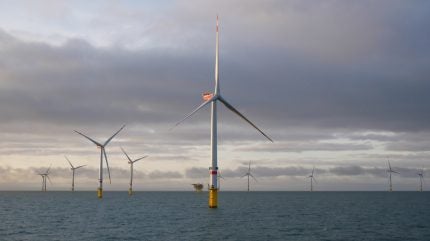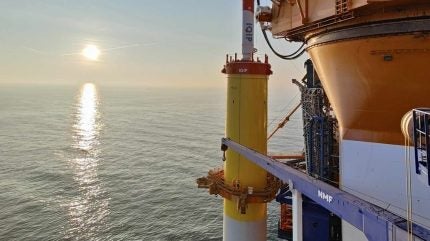Updated September 9th 2025: On 8 September 2025, a groundbreaking ceremony was held at the Port of Eemshaven to launch construction of a new warehouse facility that will support operations and maintenance for the Nordseecluster project.
The Nordseecluster offshore wind project comprises Phase A (660 MW) and Phase B (900 MW) for a total capacity of 1.6 GW. It has commenced significant foundation work, with RWE and Norges Bank Investment Management advancing one of Germany’s largest such ventures. Recent milestones include the successful installation of the first monopile for Nordseecluster A approximately 50 km off the German coast, using extended single-piece monopiles (without transition pieces) that each measure 85 m long and weigh around 1,500 tonnes, features that streamline construction and reduce steel usage.
To support Phase A, China’s Dajin Heavy Industry has completed delivery of all 45 TP-less monopiles, marking a key supply chain achievement. Meanwhile, logistics provider Mammoet has completed marshalling 116 XL monopile foundations for both Nordseecluster A and the adjacent Thor project, employing innovative load-in and storage techniques at Eemshaven to optimize safety and efficiency. However, challenges to offshore wind remain, as seen in the U.S. where Ørsted’s Revolution Wind project off Rhode Island was recently halted, underscoring how policy shifts can disrupt even large-scale renewable ambitions.
Its notable to see that corporations in Germany have also taken up the trend to go green. Most notable is Mercedes Benz 140 MW Wind Farm at its Papenburg test track in Germany. By 2030, the company aims to reduce CO₂ emissions from production by 80% compared to 2018 levels and to source 70% of its energy from renewables at its own sites.
Reported in May 28th 2025: The 1.6 GW Nordseecluster offshore wind farm has been greenlit for construction , in the German North Sea by RWE.
Phases of the Nordseecluster
The Nordseecluster will be built in two phases. Nordseecluser A, which has some key components already under construction, will have a total capacity of 600 MW. The offshore construction of this phase is expected to begin next year. Nordseecluster B, consisting of 60 turbines, will increase the capacity by an additional 900 MW. Commercial operation on the second operation is expected to begin in 2029. What’s more, in the next 3 years, all 44 wind turbines of the Nordseecluster A are planned to be connected to the national grind.
Although the cost of the project was not disclosed, RWE recently bought out Northland power, who formerly co-developed the Nordseecluster. 49% of the company’s sharehold was purchased for approximately €35 million.
Also Read: First RWE Battery Energy Storage System Construction in Netherlands
The project team
Manufacturing of the wind turbine foundations is being handled by Dajin Offshore. Van Oord will handle the sea installation of the foundations. Two offshore transformer substations will be provided by Atlantique Offshore Energy. Hellenic Cables has been tapped for the cable production at the sites. Moreover, Vestas has been chosen to supply the V236-15.0 MW wind turbines. Each of the turbines have a 15MW capacity. The transportation and installation of the turbines will be handled by Havfram Wind. They will use the ‘Norse Wind’ and ‘Norse Energi’ ships for this task.
“Our portfolio already includes six offshore wind farms off Germany’s coastlines. The Nordseecluster will add two more. This sends out a good signal for the energy transition in Germany and for RWE. In addition, with a total capacity of 1.6GW, these wind farms will generate around 6.5TWh of green electricity per year. This will contribute in particular to the decarbonisation of industry in our home market,” said Sven Utermöhlen, the RWE offshore wind CEO.
Benefiters from the project
AI data centre operators will greatly benefit from the green energy produced from the offshore wind farms in the German North Sea. Most, if not all, have decarbonization goals and tailored energy solutions such as these will aid RWE’s industrial clients. Furthermore, RWE has been exempted by The German Federal Network Agency from lease payments for the Nordseecluster sites.
Over the past two decades, RWE has put up 19 offshore wind farms into operation. This includes the six off the German coast. By 2030, the company aims to invest an additional US$60 billion into the renewable energy sector. Additionally, it includes wind, batteries and hydrogen projects. The energy giant has a goal of increasing its global offshore wind capacity three-fold from its current 3.3 GW to 10 GW in 2030.



The 1.4 GW RWE Sofia Offshore Wind farm
Just last week, the German firm installed the first offshore turbine foundation at the 1.4 GW Sofia Offshore Wind Farm in the British North Sea. Located in the Dogger Bank area, the wind farm is 195 km from the nearest British coastal point. It will have a single offshore converter platform. Moreover, power generated from the plant will be transported to the landfall in Redcar, Teesside, 220 km away. 1.2 million UK homes have been estimated to be able to benefit from the energy produced by the Sofia offshore wind farm. Further, operations and maintenance for the wind farm will be conducted from Grimsby Hub. This is RWE’s new facility which also supports the company’s Triton Knoll offshore wind farm and future projects.
Also Read: Havfram Wind and RWE seal contract for Nordseecluster wind project
Progress on the project
Last year, the subsea cable infrastructure for the project was installed. RWE is now ready to move forward with the installation of the first of 100 foundations over a 593 square-kilometre area. The installation is expected to be completed by spring 2025 however, sea conditions are expected to influence this new phase of construction.
Van Oord, a Dutch offshore construction company will be installing three foundation monopiles per cycle. The company will use the Aeolus vessel for this task. EEW has manufactured each of the foundation monopiles for the project. Siemens Gamesa is producing 100 wind turbines which each have a capacity of 14 MW. Furthermore, they will each be made of carbon and fiberglass, covering an area of 39,000m².

“Sofia is RWE’s largest offshore wind construction project to date, and its furthest from shore. Installing the first monopile is a highly symbolic moment in the construction of every offshore wind farm. After 14 years of planning and preparation, this is a great achievement for the entire RWE team. I’d like to thank everyone involved for their contribution. Building a project of this size and scale is a great opportunity to demonstrate our expertise in delivering offshore wind energy around the globe,” said Sven Utermöhlen, RWE offshore wind CEO.

